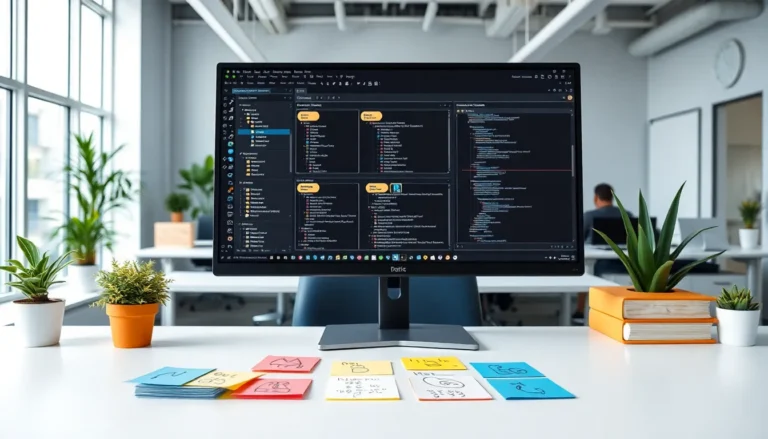Imagine walking onto a construction site where blueprints come to life before your eyes. Augmented Reality (AR) is turning this dream into reality, transforming how architects, engineers, and builders approach their projects. With AR, they can visualize complex designs and make real-time adjustments, all while avoiding the dreaded “oops” moments that lead to costly mistakes.
Table of Contents
ToggleOverview of AR in Construction
Augmented Reality (AR) transforms the construction industry by enabling real-time visualization of designs. This technology enhances decision-making and minimizes errors during construction.
Definition of Augmented Reality
Augmented reality overlays digital information onto the physical world using devices like smartphones and AR glasses. It combines computer-generated graphics with real-time data, allowing users to interact with both virtual elements and their surroundings. Common applications within construction include 3D modeling, project simulations, and remote collaboration. These applications provide clarity and context that traditional methods lack, making it easier for teams to understand complex designs.
Importance in the Construction Industry
Augmented reality plays a crucial role in improving efficiency and collaboration in construction projects. Real-time access to design models helps stakeholders visualize the final outcome, ensuring alignment between teams. By allowing for on-site adjustments, AR reduces costly errors and delays. Studies indicate that AR can cut project time by up to 10%, while also enhancing safety through improved training and hazard recognition. As the industry embraces AR, it fosters innovation and greater accuracy at every project phase.
Applications of AR in Construction

Augmented Reality technology transforms various aspects of construction. Its applications enhance overall project execution and team collaboration.
Design Visualization
Design visualization employs AR to overlay digital models onto real-world environments. Stakeholders, including architects and clients, interact with 3D models in situ. This process reveals potential issues early, allowing for immediate adjustments. Digital blueprints become tangible, providing context and clarity that improve understanding. Virtual walkthroughs also enable teams to explore designs before breaking ground, fostering more informed decision-making.
Project Management
AR streamlines project management by offering real-time data visualization. Teams access critical project information directly on-site through AR devices. This capability aids in monitoring project progress, resources, and timelines effectively. Visual overlays of construction schedules facilitate quick assessments of task completions. Teams collaborate more efficiently, reducing miscommunications that often lead to delays. Improved accuracy in project tracking results in enhanced productivity and lower costs.
Safety Training
Safety training benefits significantly from AR technology in construction. AR immerses workers in realistic scenarios to practice safety protocols without real-world risks. Training modules simulate hazardous situations and demonstrate safe practices effectively. Users engage with interactive elements, enhancing retention of safety guidelines. Immediate feedback during training sessions reinforces learning and strengthens on-site safety awareness. This proactive approach cultivates a safer work environment, reducing accidents and injuries.
Benefits of AR in Construction
Augmented Reality (AR) brings multiple advantages to the construction industry. Its integration not only streamlines workflows but also enhances communication among all stakeholders.
Improved Collaboration
Collaboration improves significantly through AR, as stakeholders visualize projects in three dimensions. Team members can interact with designs on-site, fostering dialogue and encouraging immediate feedback. Real-time data sharing enhances decision-making processes, especially during critical phases. When team members witness project elements together, they can pinpoint issues before they escalate. Engaging architects, engineers, and builders in shared AR environments promotes trust and teamwork. Collective insights result in better overall outcomes, aligning everyone towards common goals in construction projects.
Enhanced Productivity
Productivity receives a substantial boost due to AR’s ability to provide real-time updates. Workers can access digital schematics and instructions directly on-site, reducing the time spent searching for information. Immediate access to 3D models and visual overlays allows teams to track progress and troubleshoot problems efficiently. Workers experience fewer delays, enabling them to maintain momentum throughout the project lifecycle. By streamlining communication and reducing misinterpretations, AR enhances overall productivity levels in construction teams. Consequently, projects reach completion in a more timely fashion.
Cost Efficiency
Cost efficiency improves as AR helps in identifying errors early in the construction process. Early detection minimizes the risks associated with rework and additional materials, ultimately saving financial resources. Furthermore, AR facilitates better planning and resource allocation, optimizing manpower deployment. Over a project’s lifespan, these advantages can translate to significant savings. Companies also experience reduced liabilities from accidents, thanks to improved safety training provided through AR simulations. Investing in AR technology proves beneficial when it comes to long-term financial sustainability across construction projects.
Challenges and Limitations
Despite the advantages of Augmented Reality (AR) in construction, several challenges and limitations hinder its widespread adoption.
Technical Limitations
Technical limitations include hardware constraints and software compatibility issues. Not all devices support AR applications, leading to varying user experiences. Moreover, the need for high-speed internet connections can pose challenges on remote job sites. Battery life of devices also plays a crucial role; short usage periods can interrupt workflows. Additionally, AR requires accurate tracking of both people and environments, often making it unreliable in cluttered or dynamic settings.
User Acceptance
User acceptance varies significantly among professionals in the construction industry. Resistance often stems from a lack of familiarity with AR technology. Some workers might feel overwhelmed by new tools, which can hinder productivity. Training programs that focus on effective technology integration can help address these concerns. Furthermore, demonstrated benefits of AR must be clearly communicated to gain buy-in from all stakeholders.
Integration with Existing Systems
Integration with existing systems poses another challenge for AR in construction. Many companies rely on established software solutions for project management and design. Ensuring AR applications work seamlessly with these systems requires careful planning and considerable investment. Data sharing between AR and traditional tools often needs improvement. Inadequate interoperability can lead to inefficiencies, causing frustration among teams trying to implement new AR solutions effectively.
Future Trends in AR for Construction
The future of Augmented Reality (AR) in construction promises significant enhancements in various aspects of the industry. Continued advancements in technology pave the way for even greater integration of AR tools.
Advancements in Technology
Rapid technological progress influences the development of AR applications. Enhanced processing power and improved hardware capabilities enable more precise overlays and interactive experiences. Emerging technologies, like 5G, offer faster and more reliable connectivity, making real-time data sharing feasible on job sites. Cutting-edge devices, such as AR glasses, provide users with hands-free access to essential project information. Companies increasingly focus on creating user-friendly interfaces to help workers adopt these tools seamlessly. Innovations in software improve compatibility, allowing AR applications to work alongside existing project management systems. Such advancements may drive the industry’s acceptance of AR technologies.
Potential Market Growth
The construction industry anticipates substantial market growth for AR over the coming years. According to recent data, the global AR market in construction is projected to reach $11 billion by 2026, reflecting a compound annual growth rate of 55.2%. Growing investments in technology showcase the increasing recognition of AR’s value. Stakeholders recognize that enhanced visualization and collaboration can lead to improved project outcomes. Moreover, rising demand for efficiency and safety further propels AR adoption. Companies that implement AR technologies stand to benefit from streamlined operations and reduced costs. As awareness expands, more industries will likely explore AR’s potential, contributing to ongoing market growth.
AR is transforming the construction industry by enhancing visualization and collaboration. Its ability to overlay digital information on the physical world allows teams to make informed decisions quickly and accurately. As the technology evolves and becomes more accessible, its adoption will likely increase, driving efficiency and reducing costs across projects.
While challenges remain, the potential benefits of AR are too significant to ignore. The industry’s future looks promising as companies embrace these innovations. By integrating AR effectively, construction teams can not only improve project outcomes but also foster a culture of safety and efficiency that will benefit the entire sector.









